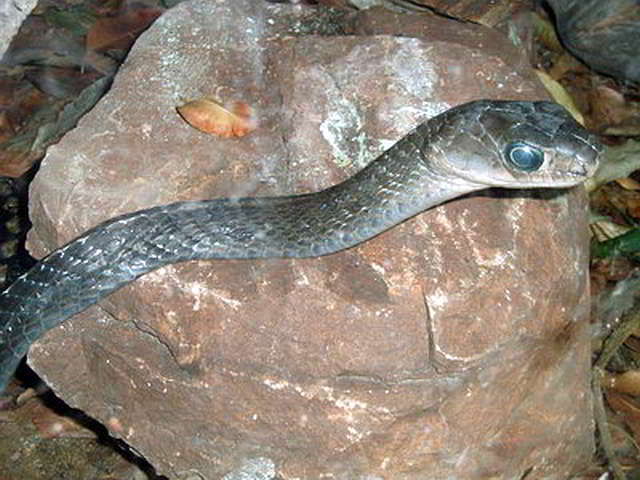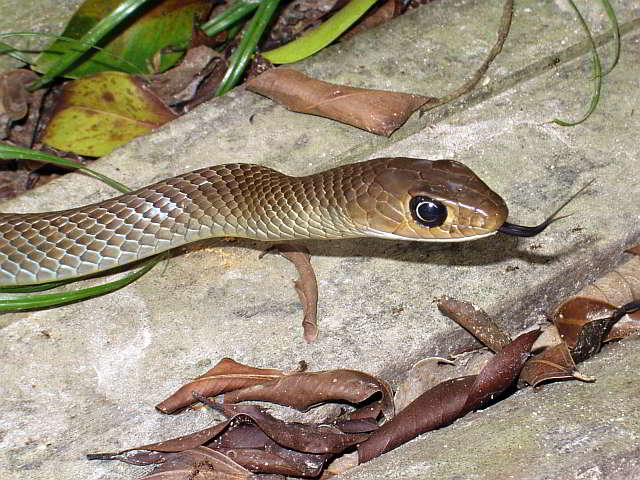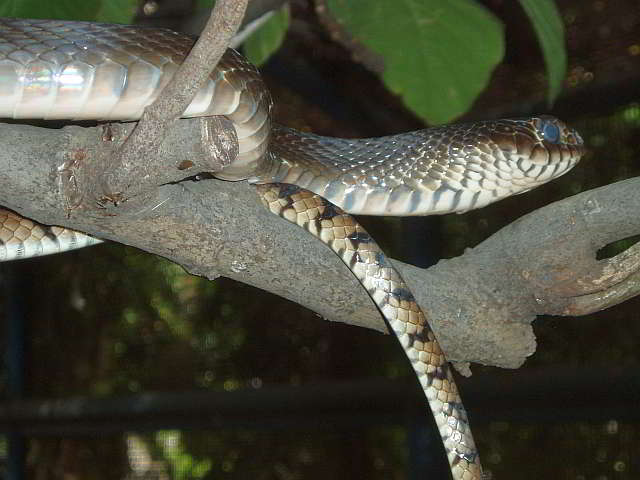 Family: Colubridae
Family: ColubridaeSubfamily: Colubrinae
Genus: Ptyas (Rat Snakes)

Picture: J. Bulian
 Ptyas fusca
Ptyas fuscaThai:
 (ngu sing thai)
(ngu sing thai)Length: up to 290 cm
Distribution area: The snake lives in the southern provinces of Thailand from Suratthani.
Habitat and behaviour: This snake, which is imposing due to its size, lives is primary and secondary woods up to a height of approx. 900 meters. However as a cultural follower, you can also come across the species on oil palm plantations and nearby human settlements. These snakes are active in the daytime and at twilight. You can usually find them on the ground on the hunt for lizards and rodents. They spend the night curled up in loose bundles in bushes and on branches up to a height of around 3 meters. If they are disturbed at night or attacked, they react astonishingly lost and generally do not even try to bite. Due to their size, they do have rather large teeth; therefore a bite is not dangerous but can be painful.
Danger level: none
This is a large but non-venomous reptile.

Picture: J. Bulian
 Ptyas korros (Indochinese Rat Snake)
Ptyas korros (Indochinese Rat Snake)Thai:
 (ngu sing ban)
(ngu sing ban)Length: A little over 100 cm
Distribution area: Throughout Thailand, but predominantly in the lowland areas.
Behaviour: A snake which is active during the day, is very fast and which usually flees from humans before they get too close. If cornered, the snake bites very quickly and can even jump at their aggressor. This snakes helps keep rats and mice at bay.
Danger level: None

Picture: J. Bulian
 Ptyas mucosa (Oriental Rat Snake)
Ptyas mucosa (Oriental Rat Snake)Thai:
 (ngu sing hang lai)
(ngu sing hang lai)Length: up to 370 cm but the snakes are normally smaller.
Distribution area: throughout Thailand
Behaviour/habitat: The Oriental Rat snake lives in open forests as well as in cultivated landscapes (e.g. plantations). It inhabits predominantly the ground but is also an outstanding climber. These snakes are active during the day and at dawn. At night the snakes can be found rolled together, sleeping on shrubs and in the branches of trees. They are relatively easy to catch. The eyesight of the snakes does not seem to be particularly good at night, because animals which were found at night appeared to be disoriented. They eat practically everything that they can catch and their diet includes rodents, birds, snakes, lizards, bats, frogs, and toads. There is even a reported case of the Ptyas mucosa being fed a young turtle.
Large specimens do not strangle their prey, but crush them with their body weight. Smaller victims are usually eaten live. The primary mating season extends from April to June. Animals from southern Thailand may reproduce throughout the year. Ritual codes of behaviour and fighting have been observed in males during the mating season. During this time the animals intertwine themselves with parts of the front body, parts of the trunk, and parts of the tail in contact. About 2 months after the mating, the females lay between 6 and 18 eggs. The young animals are hatched approximately 60 days later. They have a general length of between 36 and 47 centimetres and contrary to the adults, they are very pale.
Danger level: Small, newly captured animals can bite quite violently. In captivity however they can become quite docile.
Mildly-venomous/non-venomous snakes of Thailand
Venomous snakes of Thailand
≡ Menu
All data is provided without guarantee!